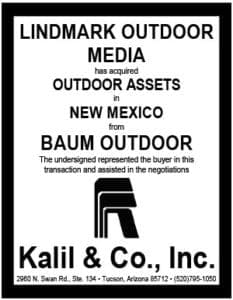
By Jim Moravec, general partner, Stott Outdoor Advertising. This article originally appeared in Morning Consult and is reprinted by permission.
With traffic congestion and aging infrastructure, America faces an intriguing question: Should the government auction pieces of the public’s highways to pay for transportation?
California is a focus of this national debate. Hungry for road money, it wants to sell advertising on official public traffic signs. This is a bad idea.
I operate the billboard company Stott Outdoor Advertising based in Chico, Calif. My state’s pride in innovation, invention and pioneering spirit is well deserved; Sierra Nevada Brewing Co. was founded in Chico.
But auctioning public traffic signs is not a building block to leadership. On the contrary, allowing ads on highway signs would up-end the well-established policy that official signs are for traffic control and management, not advertising.
The proposal in California is important nationwide because California is a bellwether, and the federal government would have to give its blessing. California’s transportation agency, Caltrans, is circulating a report to the state Legislature that essentially says California can’t afford to upgrade traffic signs. Therefore, the state is making the case that it should be allowed to sell ads on traffic signs to pay for new signs while also earning millions for the state.
The legality of the proposal is questionable, so California is seeking state and federal “waivers” — a magic wand to make rules simply go away.
Caltrans’ appetite to venture into the billboard business is not new. A decade ago, it sought federal permission to sell ads on traffic signs. The U.S. Department of Transportation declined to green-light the idea.
Sen. Dianne Feinstein (D-Calif.), an opponent, wrote to Transportation Secretary Ray LaHood in 2010: “The waiver was not granted by the Department (US-DOT) in 2008, and I remain strongly opposed to any such effort that may increase driver distraction.”
In 2016, a California Senate committee voted 19-17 to reject legislation to put ads on highway traffic signs.
The Trump administration has upheld this principle. Texas wanted to auction corporate sponsorships of traffic signs that overhang highways. In 2017, the Federal Highway Administration said no.
A Pennsylvania motorist proposed selling ads on the blank, back sides of highway signs. Again, the feds said no last year, citing the federal manual that sets sign standards: “Traffic control devices or their supports shall not bear any advertising message or any other message that is not related to traffic control.”
Billboards located outside the public highway right of way are regulated by federal, state and local rules on size, lighting, spacing and zoning. California’s proposal for billboards on the highway (public right of way) recommends an exemption from spacing and zoning rules for its billboards.
Caltrans’ proposal calls for 25 electronic billboards on highways in metro Los Angeles, San Francisco and Sacramento, phased in over four years. Advertising, the plan claims, would pay to buy and operate new billboards. Plus, ad revenue would generate up to $10.2 million a year for Caltrans. To me and many others in the billboard business, these projections seem exaggerated.
There’s also the tricky issue of what would be deemed appropriate advertising. Where would the government draw the line to limit messages on billboards on public space on highways? Would it allow commercial messages only, or would religious and political messages be allowed?
I don’t know, and no one else does, either. But I’m pretty sure that the state of California, which projects a budget surplus, has better things to do. The federal government — and members of the U.S. Congress — should help by rejecting California’s request for permission to move ahead with this bad idea.
[wpforms id=”9787″]
Paid Advertisement

















